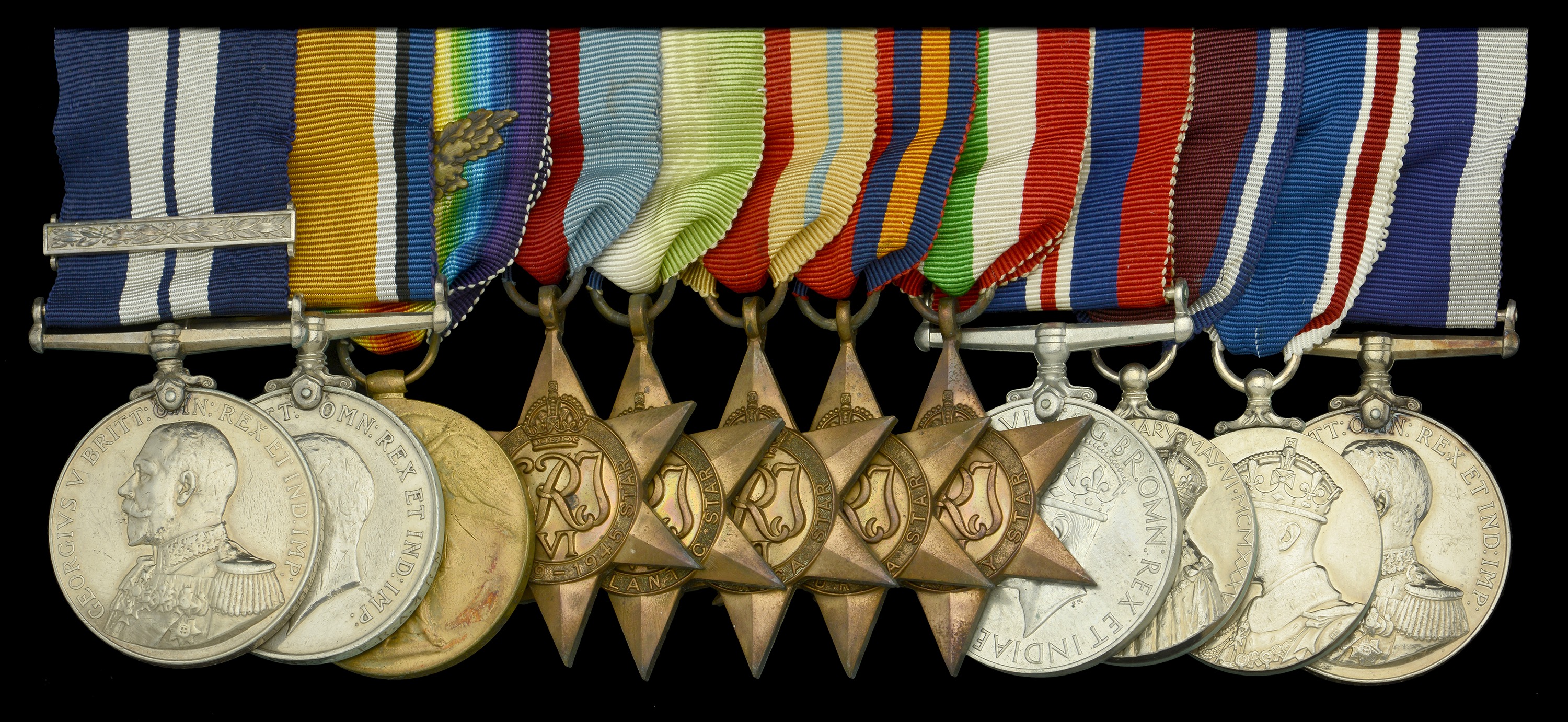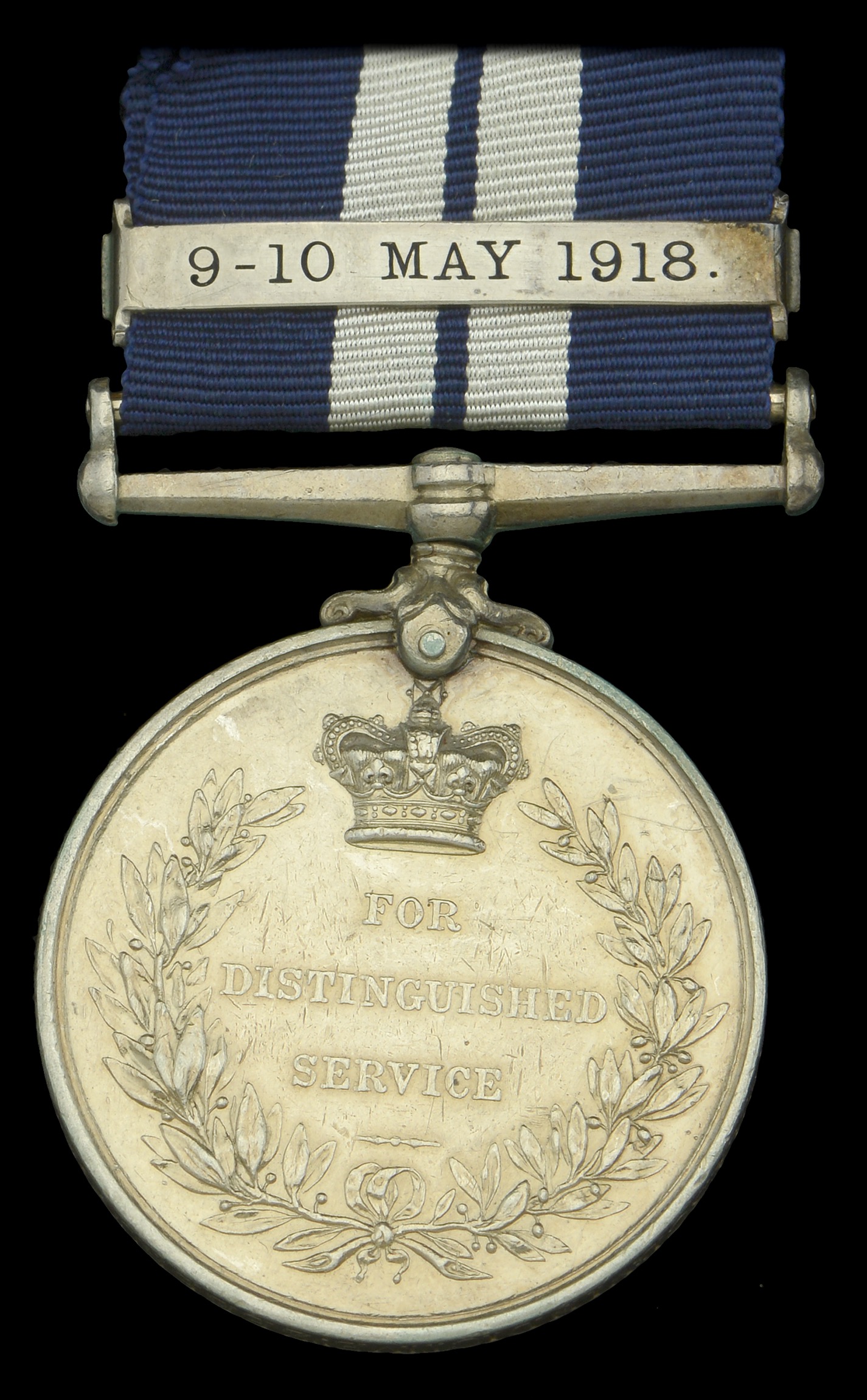The extremely rare Great War D.S.M. and Bar group of twelve awarded to Chief Engine Room Artificer H. A. Harris, Royal Navy, awarded the D.S.M. for his gallantry in H.M.S. Vindictive in the Zeebrugge raid in April 1918 and participated in the ballot for the V.C.; he received a Bar for like services in the subsequent raid on Ostend in May 1918, thereby becoming one of only four ‘double D.S.M.s’ for these operations Distinguished Service Medal, G.V.R., with Second Award Bar (M.6218. H. A. Harris, E.R.A. 3Cl. “Vindictive.” Zeebrugge-Ostend. 22-3. Apl. 1918.) the reverse of the Bar officially impressed ‘9-10 May 1918’; British War and Victory Medals, with M.I.D. oak leaves (M.6218 H. A. Harris. E.R.A. 4 R.N.); 1939-45 Star; Atlantic Star; Africa Star; Italy Star; Burma Star; War Medal 1939-45; Jubilee 1935; Coronation 1937; Royal Navy L.S. & G.C., G.V.R., 2nd issue with fixed suspension (M.6218 H. A. Harris. E.R.A.1. H.M.S. Centaur) minor official correction to official number on the last, light contact marks, very fine or better (12) £4,000-£5,000 --- Importation Duty This lot is subject to importation duty of 5% on the hammer price unless exported outside the UK --- --- Provenance: Dix Noonan Webb, June 1999. Just 67 Bars were awarded to the D.S.M. in the Great War. D.S.M. London Gazette 23 July 1918: ‘For services during the operations against Zeebrugge and Ostend on the night of 22-23 April 1918.’ Bar to D.S.M. London Gazette 28 August 1918: ‘The following awards have been approved.’ The recommendation states: ‘H.M.S. Vindictive. Zeebrugge-Ostend 9-10 May 1919. The following [four] Engine Room Artificers distinguished themselves in H.M.S. Vindictive during the attack on Zeebrugge Mole on 23 April 1918. They immediately volunteered for further service in H.M.S. Vindictive and behaved with conspicuous bravery in that ship on the night of 9-10 May 1918. No other ratings in H.M.S. Vindictive volunteered for the second operation.’ Herbert Alfred Harris was born at Gosport, Hampshire on 10 July 1897, and entered the Royal Navy as a Boy Artificer in July 1913. At the time of his volunteering for the famous Zeebrugge raid in April 1918, he was serving as an Engine Room Artificer 4th Class in H.M.S. Royal Sovereign, and was one of the four E.R.A.s assigned to the care of Vindictive’s engines: all of them were subsequently awarded the Distinguished Service Medal and took part in the ballot for the award of the Victoria Cross. Vindictive’s role as a landing ship was of course crucial, acting as she did as a decoy to the raid’s accompanying blockships, so much so that her part in the raid had been the subject of wide praise and coverage. Captain A. F. B. Carpenter, R.N., one of five men to be awarded the V.C. for Vindictive’s efforts that memorable night, later recalled the hot reception afforded the ship as it closed the Mole: ‘They literally poured projectiles into us. In about five minutes we had reached the Mole, but not before the ship had suffered a great amount of damage to both material and personnel.’ And the carnage continued apace as her Royal Marine landing parties desperately tried to get ashore in the face of point-blank fire. But the performance of the engine room department, under Engineer Lieutenant-Commander W. A. Bury, was no less praiseworthy, he and his artificers having to shift from going full speed astern to full speed ahead, in an effort to maintain the much-battered cruiser’s position on the Mole. And when at 12.50 a.m. the recall signal was received, they managed to muster a speed of 17 knots. In total, 176 officers and men were killed in the raid and 412 wounded. Such was the bravery of all those involved that Article 13 of the Victoria Cross warrant was invoked. This stipulates that, when a corps or unit so distinguishes itself as to make it impossible to single out individuals, Crosses should be awarded by a ballot of those who survived. Two Victoria Crosses were awarded to the Royal Navy by this method, and another two to the Royal Marines. Under a further provision of Article 13, all those who did not receive the V.C. had their service records annotated to the effect that they had participated in the ballot for the V.C.: Harris’s service record is thus annotated, together with a note in respect of his award of the D.S.M. For the second raid on Ostend in May 1918, in which Vindictive was to act as one of the blockships, Vice-Admiral Keyes intended to allow the Senior Engineer present to take charge of the Vindictive’s engines, but Engineer Lieutenant-Commander Bury protested strongly against leaving the ship, and claimed his right to remain in Vindictive: ‘This very gallant officer, who greatly distinguished himself on 23 April, represented that his knowledge of the engines and boilers of his ship should be utilised. He further begged that Engine Room Artificers Hubert Cavanagh, Norman Carroll, Alan Thomas, and Herbert Alfred Harris, who also volunteered, might be allowed to remain with him. Keyes acceded to his request.’ And so, in the early morning mist on 10 May, Vindictive made her last eight-point turn, then steamed through the canal entrance at Ostend. Bury and his four E.R.A.s had experienced little trouble with the engines despite the hastily patched-up steam pipes which had been severely damaged by gunfire at Zeebrugge. In fact, to begin with, all was well below deck, the 35 men in the engine-room performing their duties admirably. And with Vindictive in position across the channel of the canal, Lieutenant Victor Crutchley gave orders for the ship to be abandoned, preparatory to the firing of the charges which would sink Vindictive, thereby blocking the channel. Crutchley, who had earlier been wounded by a direct hit on the bridge and assumed command after his captain was killed, displayed great courage. Having made every endeavour by manoeuvring his engines to place the ship in an effective position, he did not leave her until he had made a thorough search with an electric torch for survivors, under a very heavy fire. And that heavy fire now took its toll below decks, Engineer Commander Bury being severely wounded. But he remained in the engine-room until the last possible moment, and when everyone was clear, he blew the bottom out of the ship, by firing the main and auxiliary after charges. Three of his gallant E.R.A.s were saved; the fourth, Alan Thomas, was missing, but it was later learnt that he had been picked up by the Germans and taken prisoner. Harris was among those who escaped the embattled harbour in M.L. 254, commanded by Geoffrey Drummond, who, in common with Crutchley, was awarded a V.C. for his heroics that night. For his own part, Harris was awarded a Bar to his D.S.M. and, later still, a ‘mention’ (London Gazette 19 February 1919, refers). In the inter-war years, Harris served in the submarine Cachalot from May 1927 to January 1928, aside from a short period aboard the patrol boat H.M.S. P40 for a week in October 1927. He joined Centaur on 9 January 1928 and received his L.S. & G.C. medal the following July. He subsequently gained advancement to Chief Engine Room Artificer and signed up for a second term of ‘non-continuous’ engagement in July 1937, when he was assigned the service number P/MX. 54929.









